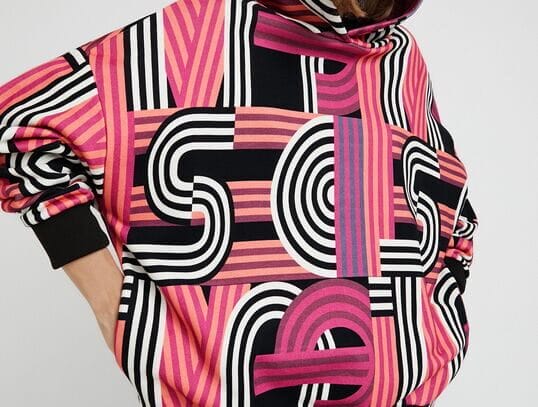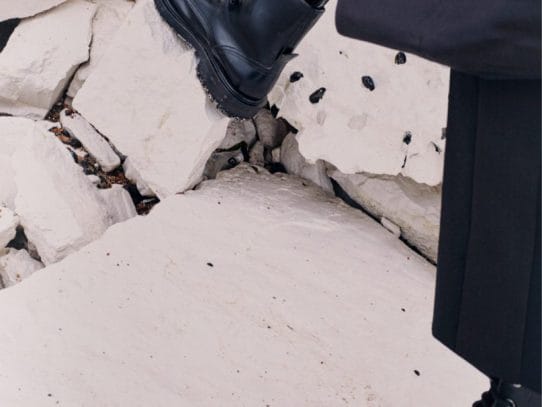Explore how GCAL merges cutting-edge AI technology with expert craftsmanship to redefine diamond grading. Dive into their commitment to transparency, ethical sourcing, and precision in this exclusive feature.
When you think of diamonds, images of eternal beauty, luxury, and timelessness come to mind. But how can consumers ensure that the dazzling stone they purchase is truly worth its price? To answer this, we must first delve into the fascinating history of diamond cutting and grading—two pillars that have shaped the diamond industry for centuries.
The Origins of Diamond Cutting: A Journey Through Time
The art of diamond cutting dates back to the 14th century. The first recorded instance of mankind cutting diamonds occurred in 1375 in Venice, Italy. Known as the “point cut,” this rudimentary method involved polishing the natural octahedral shape of rough diamonds to enhance their brilliance. At the time, diamonds were prized for their hardness and mystique, believed to possess protective and healing properties. The rise of diamond cutting was driven by a desire to unlock the stone’s true potential, both in beauty and symbolic value.
As techniques evolved, cities like Antwerp emerged as global hubs for diamond cutting during the Renaissance. By the 17th century, cutters began experimenting with facets, leading to the development of the “rose cut.” The introduction of modern brilliant-cut diamonds in the early 20th century marked a pivotal moment, setting the stage for the dazzling masterpieces we admire today.
The Birth of Diamond Grading: Establishing Standards
The concept of diamond grading as we know it began in the mid-20th century. In 1953, the Gemological Institute of America (GIA) revolutionized the industry by introducing the “4Cs” grading system: cut, color, clarity, and carat weight. This system provided a standardized framework to assess and compare diamonds, enabling buyers to make informed decisions.
The need for diamond grading arose from a rapidly expanding global market where variations in quality and inconsistent terminology created confusion and mistrust among consumers. By establishing objective criteria, the GIA laid the foundation for a more transparent and credible diamond trade. Today, grading has become both an art and a science, demanding precision, expertise, and a commitment to integrity.
How AI Is Transforming Diamond Grading
The diamond industry is now undergoing another transformative phase, thanks to artificial intelligence (AI). Traditional grading methods, while reliable, are labor-intensive and sometimes prone to human error. Enter GCAL(Gem Certification & Assurance Lab), a pioneering force in combining expert knowledge with state-of-the-art AI technology.
GCAL’s revolutionary approach enhances the accuracy, consistency, and comprehensiveness of diamond grading. Their innovative systems, such as the 8X Cut Grade evaluation and Gemprint technology, go beyond the basics. Using advanced imaging and data analysis, AI identifies minute details that even the most trained eye might miss, ensuring unparalleled precision in every report.
What Sets GCAL Apart
At GCAL, the focus is on empowering consumers with reliable, transparent information. Their ISO 17025-accredited grading certificates provide an in-depth analysis of a diamond’s characteristics, including its cut, color, clarity, and carat weight. Unlike traditional reports, GCAL offers a money-back guarantee, instilling confidence in buyers during one of the most significant purchases of their lives.
Additionally, GCAL’s unique 8X Cut Grade evaluation ensures optimal light performance, symmetry, and polish, guaranteeing that every certified diamond truly dazzles. Paired with their proprietary Gemprint technology—a unique “fingerprint” for diamonds—GCAL is redefining industry standards.
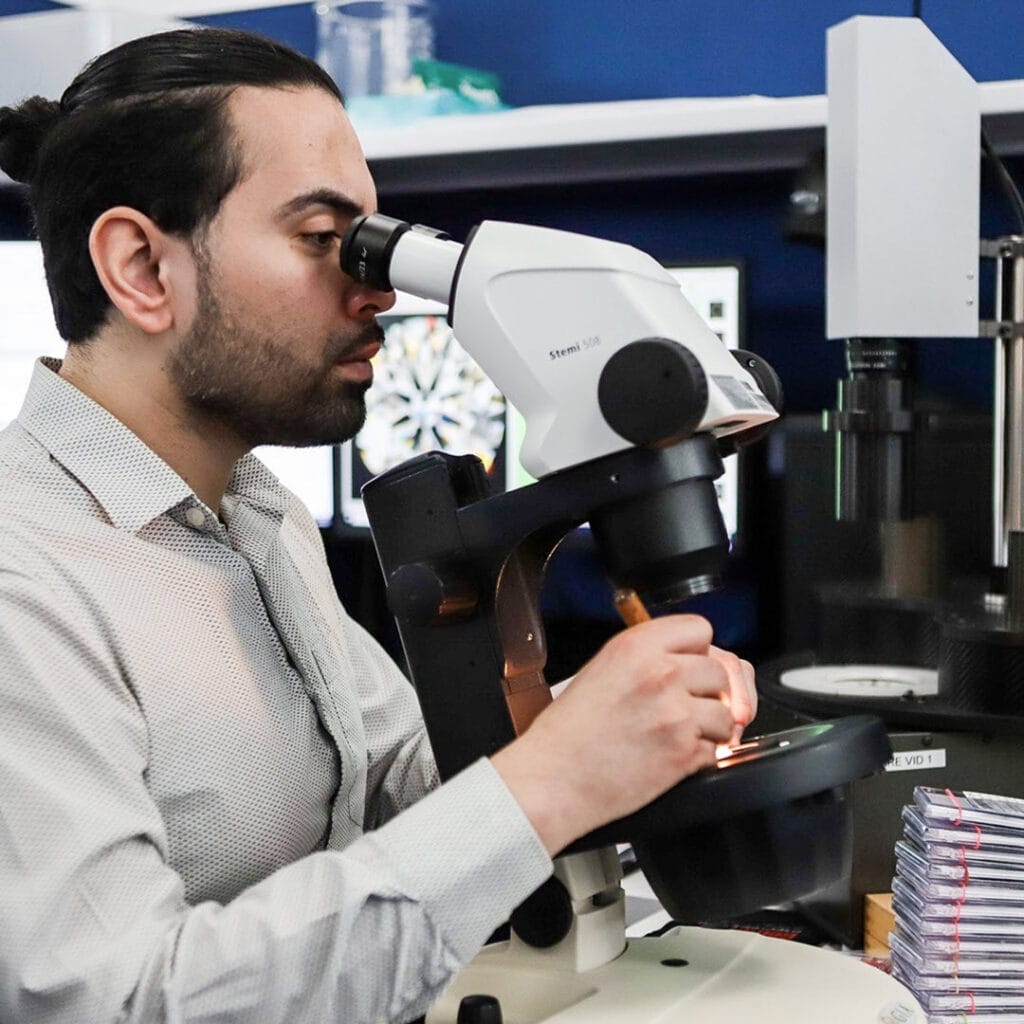
Throughout my career as a luxury editor, I have had the privilege of observing the evolution of the diamond market, from its traditional roots to the cutting-edge advancements of today. The art and science of diamond grading have always been fascinating, but few companies have captured my attention the way GCAL has. Their commitment to precision, transparency, and ethical practices sets them apart in an industry where trust and authenticity are paramount. As someone deeply immersed in the luxury sector, I have come to appreciate how innovations like GCAL’s 8X Cut Grade System and their emphasis on traceability through technologies like Gemprint® are reshaping consumer expectations and elevating standards across the board.
One of the most transformative developments I’ve witnessed is the integration of artificial intelligence into diamond grading. AI brings unparalleled accuracy, speed, and consistency, qualities that are indispensable in a market where even minute variations can have significant implications for value and desirability. However, what makes this moment truly revolutionary is the synergy between AI and seasoned industry experts. At GCAL, for instance, the collaboration between advanced technology and human expertise ensures that the nuances and artistry of diamond grading are not lost. This balance has allowed for a deeper level of trust and transparency, as consumers can now make informed decisions with confidence in both the science and the craftsmanship behind their purchases.
We are undoubtedly living in a pivotal era for the diamond industry. The marriage of cutting-edge technology and ethical innovation is not only transforming how diamonds are graded but also reshaping how they are perceived and valued by consumers. For me, as someone who has chronicled the luxury market for years, this shift represents an exciting new chapter—one where tradition and modernity coexist to create a more transparent, responsible, and consumer-focused industry. GCAL is at the forefront of this revolution, and witnessing their impact firsthand has reaffirmed my belief in the potential of this transformative period for diamonds and luxury at large.

An Exclusive Interview with Angelo Palmieri: Revolutionizing the Diamond Industry
I recently had the privilege of sitting down with Angelo Palmieri, the esteemed president of GCAL (Gem Certification & Assurance Lab), to discuss three vital topics shaping the diamond industry today: the evolution of diamond grading, the integration of AI technology in diamond certification, and the importance of ethical sourcing and sustainability. Our conversation provided fascinating insights into how GCAL is setting new standards in transparency and precision for discerning diamond buyers.
Joseph DeAcetis: What makes GCAL’s diamond grading process stand out from traditional grading methods?
Angelo Palmieri:
At GCAL, we are committed to precision, transparency, and ensuring our clients’ trust. Our proprietary 8X Cut Grade System, Gemprint® technology, and ISO 17025 accreditation set us apart. Specifically, our 8X Cut Grade helps us rise above the rest by extending our offering beyond traditional grading, introducing a comprehensive evaluation system that applies to even the fanciest trending shapes like Oval, Princess, and Pear. Implemented alongside our Gemprint® technology, which provides a ‘fingerprint’ unique to every stone, we can ensure traceability and authenticity. This cutting-edge technology, paired with our ISO accreditation, emphasizes our dedication to instilling the highest standards for accuracy and credibility in diamond grading.
Joseph DeAcetis: Can you explain how your 8X Cut Grade evaluation system works and why it’s an essential part of your grading process?
Angelo Palmieri:
The 8X Cut Grade System examines eight unique aspects of a diamond’s cut, including symmetry, brilliance, fire, and polish, to list a few. It’s especially important because cut directly influences not only a diamond’s aesthetic appeal but also its overall value. This is crucial for fancy shapes, in particular, as traditional grading often overlooks precise criteria for these shapes. That’s not how we choose to operate. Our system ensures consistency and fairness across all shapes. It’s a meticulous process, but one we’re happy to perform because it not only assures jewelers of a diamond’s quality but also allows customers to feel confident in their investment.
Joseph DeAcetis: How do your proprietary Gemprint technology and ISO 17025 accreditation contribute to consumer confidence when purchasing diamonds?
Angelo Palmieri:
Gemprint® technology strengthens customer trust by uniquely identifying each diamond with its optical ‘fingerprint,’ data which is then registered in an international database. This serves multiple purposes, one of the most important being that owners can verify and recover their diamonds in the unfortunate circumstances of loss or theft. Additionally, our ISO 17025 accreditation supplements the precision and consistency of our grading, reinforcing our reputation as reliable, accountable, and consistent in an industry that demands trust.
Joseph DeAcetis: With the rise of AI technology in various industries, how do you foresee its role in transforming diamond grading and the overall jewelry market?
Angelo Palmieri:
AI is already revolutionizing diamond grading through enhanced accuracy, increased speed, and elevated objectivity. At GCAL, we bolster our gemologist’s expertise with advanced AI algorithms, ensuring precision without sacrificing the nuanced judgment only humans can provide. In the broader jewelry market, we’ve only scratched the surface of AI’s potential applications, including streamlining sourcing, improving traceability, and personalizing the customer’s experience, making the industry more transparent (pun intended) and consumer-focused.
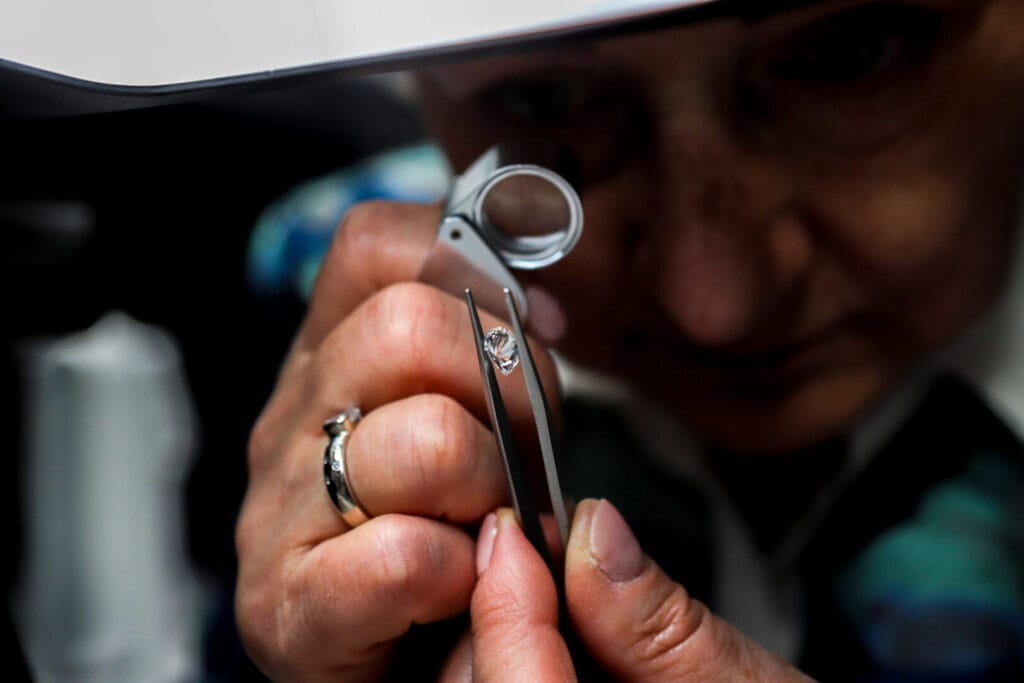
Joseph DeAcetis: Many consumers are concerned about the ethical implications of diamond mining. How does GCAL ensure that the diamonds it certifies are responsibly sourced?
Angelo Palmieri:
GCAL works with partners that prioritize ethical sourcing and sustainability while employing technologies like Gemprint® and mine-of-origin tracking systems to ensure traceability. This helps us certify not just the quality but also the integrity of the diamonds we grade. Supporting initiatives that promote responsible mining practices and fair labor standards throughout the supply chain remains a top priority for us.
Joseph DeAcetis: What common misconceptions do consumers have when purchasing diamonds, and how can they avoid making costly mistakes?
Angelo Palmieri:
One common misconception we see is consumers equating a diamond’s carat weight with its intrinsic value. While carat is an important characteristic, cut, clarity, and color also significantly influence a diamond’s beauty and worth. Another common misinterpretation is that all grading certificates are created equal. Unfortunately, there is room for bias and misrepresentation in this industry. To avoid mistakes, consumers should seek out labs with strict standards, like GCAL, and have a firm understanding of the 4Cs before making a purchase.
Joseph DeAcetis: How do you see the diamond industry’s future evolving regarding sustainability and innovation?
Angelo Palmieri:
Today’s consumers are smarter, with more readily available information and higher standards than ever before. I believe the future of the diamond industry lies in enhanced transparency, sustainable practices, and continuous technological advancements, particularly in the realm of AI. GCAL is at the forefront of these changes, advocating for traceable sourcing and leveraging AI to improve grading accuracy. Innovation will continue to redefine consumer behaviors and expectations, emphasizing ethics and sustainability just as much as quality.
Joseph DeAcetis: What advice would you give to those looking to gift a diamond but feeling overwhelmed by the choices available?
Angelo Palmieri:
First, have a budget in mind. Understand your threshold and what you’re willing to spend. Then, make sure you have a firm understanding of the 4 C’s—Carat, Cut, Color, and Clarity. Insist on a reputable and reliable certification, such as GCAL’s, to guarantee accuracy and transparency. Finally, don’t hesitate to ask questions and compare options. Diamonds are a big purchase, and a well-informed decision ensures your stone is meaningful and valuable.
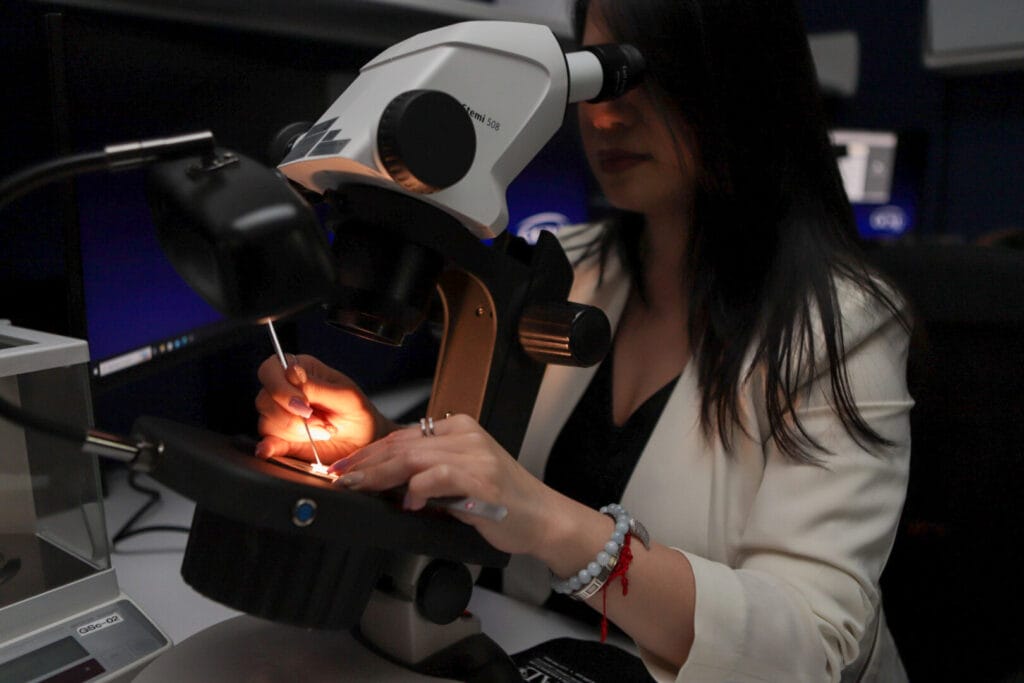

Joseph DeAcetis: Can you tell us more about the customer protection GCAL offers to ensure that diamonds are accurately represented and that buyers are confident in their purchase?
Angelo Palmieri:
Authenticity and honesty are paramount to GCAL’s offering. We provide an unmatched guarantee, ensuring the accuracy of our reports. We also supply hi-res images and comprehensive documentation with every certification, assuring and empowering customers with detailed information about their diamond. Our commitment to precision and transparency helps us build long-term trust with our clients.
Joseph DeAcetis: Finally, what is your vision for the future of GCAL and its role in shaping the global diamond industry?
Angelo Palmieri:
GCAL vies to set the gold standard in diamond grading by fostering innovation, prioritizing transparency, and investing in ethical practices. We aim to continue pioneering advancements in grading technology while advocating for sustainability and championing consumer education. Ultimately, we aim to build a diamond industry rooted in trust and integrity.
The Future of Diamonds: Where Tradition Meets Technology
As AI continues to revolutionize the diamond industry, the expertise and craftsmanship honed over centuries remain vital. At GCAL, this synergy between tradition and innovation is paving the way for a brighter, more transparent future for diamond buyers worldwide.
So, as you consider gifting diamonds this holiday season, remember: all that glitters may not be gold, but with GCAL, you can be sure your diamonds are as brilliant and authentic as they appear.
Conclusion: Buying a diamond is more than a purchase; it’s an investment in a story, a memory, and a legacy. By understanding the history of diamond cutting and grading and embracing the cutting-edge advancements pioneered by GCAL, consumers can make informed decisions with confidence. After all, the true value of a diamond lies not only in its sparkle but in the assurance of its quality.
Save Article








